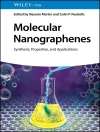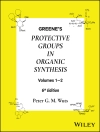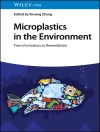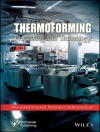Foundational knowledge and practical approaches of an interesting catalyst class for greener and cleaner chemical synthesis
Solid Base Catalysts provides insights and information on cutting-edge heterogeneous catalysis technologies and approaches of non-corrosive and easy-to-use solid catalysts that can replace conventional liquid catalysts that are known to pose operational problems.
Edited by three highly qualified authors with contributions from experts in industry and academia, Solid Base Catalysts includes:
- Latest and most advanced studies in the characterization of solid catalysts, with applications in various organic transformations
- Versatile reaction types where solid catalysts can be used as well as the multidisciplinary nature of solid base catalyst research and its connections to other fields
- Multicomponent reactions for eco-compatible heterocyclic synthesis over solid catalysts and synthesis routes, experimental protocols, and other considerations for optimizing catalyst properties
- Advanced methodologies and applications for analyzing solid catalysts and challenges and future prospects in the field
Solid Base Catalysts is a complete reference on the subject for researchers and professionals in materials science, green chemistry, surface chemistry, and chemical engineering.
Tabela de Conteúdo
Preface xiii
1 Introduction to Solid Base Catalyst 1
Indu Sindhu, Ravi Tomar, and Anshul Singh
1.1 Introduction 1
1.2 History and Main Facts on Solid Base Catalysts 2
1.3 Literary Perspective of Solid Base Catalyst 3
1.4 Solid Basic Sites 4
1.5 Types of Solid Base Catalysts 5
1.5.1 Metal Oxides 5
1.5.1.1 Alkaline Earth Oxides 5
1.5.1.2 Zirconium Oxides 6
1.5.1.3 Rare Earth Oxides 7
1.5.1.4 Titanium Oxides 9
1.5.1.5 Zinc Oxide 9
1.5.1.6 Alumina 10
1.5.1.7 Mixed Oxides 10
1.5.1.8 Alkali Metal-Loaded Metal Oxides 10
1.5.2 Zeolites 11
1.5.3 Mesoporous Materials 13
1.5.4 Clay Minerals (Hydrotalcite) 13
1.5.5 Oxynitride 14
1.5.6 Calcined Metal Phosphates 14
1.6 Why Solid Base Catalysts Have Fascinated the Scientific Community? 16
1.7 Advantages and Disadvantages of Solid Base Catalysts Over Inorganic/Organic Bases 17
1.8 Role of Solid Base Catalysts in Green Chemistry 18
1.9 Future Prospects for Solid Base Catalysts 20
1.10 Conclusion 20
References 21
2 Synthesis of Solid Base Catalysts 27
Chetna Kumari, Nishu Dhanda, Nirmala Kumari Jangid, and Sudesh Kumar
2.1 Introduction 27
2.2 K2O/Al2O3–Ca O 27
2.2.1 Preparation of K2O/Al2O3–Ca O 28
2.2.1.1 Preparation of Al2O3–Ca O Mixed Oxides Basic Support 28
2.2.1.2 Potassium Nitrate Loading with Calcined Mixed Oxides Basic Support 28
2.2.2 Catalytic Activity of K2O/Al2O3–Ca O in the Knoevenagel Condensation Process for the Preparation of Benzylidene Barbituric and Benzylidenemalononitrile Derivatives 28
2.2.3 Catalytic Activity of K2O/Al2O3–Ca O for the Preparation of Pyrano[2, 3-d]pyrimidinone Derivatives 29
2.3 Solid Base Fly Ash 30
2.3.1 Synthesis 30
2.3.2 Catalytic Activity of SBFA 30
2.3.3 Condensation Between Benzaldehyde and Cyclohexanone 31
2.3.4 Catalyst Regeneration 31
2.4 Calcined Water Sludge 31
2.4.1 Catalyst Preparation 32
2.5 Oxides of Rare Earth 32
2.5.1 Preparation 32
2.6 Titanium Dioxide 33
2.6.1 Preparation 33
2.7 Zinc Oxide 34
2.7.1 Preparation 34
2.8 Alkaline Earth Oxides 34
2.8.1 Preparation 35
2.8.1.1 Conventional Method for Mg O Catalyst 35
2.8.1.2 Effects of Starting Magnesium Salt 35
2.8.1.3 Preparation of Mg O by Sol–Gel Method 36
2.8.1.4 Preparation of Mesoporous Mg O 36
2.8.1.5 Catalytic Activity for Claisen–Schmidt Reaction 37
2.9 Hydrotalcite 38
2.9.1 Synthesis of Hydrotalcite 38
2.9.1.1 Coprecipitation Method 38
2.9.1.2 Sol–Gel Method 39
2.9.1.3 Michael Addition 39
2.10 Comparison of Different Solid Base Catalysts 39
2.11 Conclusion 42
Conflicts of Interest 42
Acknowledgment 42
References 42
3 Advanced Characterization Techniques for Solid Base Catalysts: An Overview 51
Neelam Sharma, Suman Swami, Sakshi Pathak, Aruna, and Rahul Shrivastava
3.1 Introduction 51
3.2 Traditional Characterization Techniques for Solid Base Catalyst 55
3.2.1 Titration Method 55
3.2.2 IR Analysis 56
3.2.3 Scanning Electron Microscopes 58
3.3 Advanced Characterization Techniques for Solid Base Catalyst 59
3.3.1 Fourier Transform Infrared Spectroscopy (FT-IR) 59
3.3.2 Field Emission Scanning Electron Microscopes (FE-SEM) 62
3.3.3 Transmission Electron Microscope (TEM) 66
3.3.4 X-ray Diffraction (XRD) Analysis 68
3.3.5 Thermogravimetric Analysis (TGA) 73
3.3.6 Brunauer–Emmett–Teller BET Surface Area Pore Diameter Analysis [Gas Interaction and Surface Area Measurement: (Brunauer–Emmett–Teller (BET), Barrett–Joyner–Halenda (BJH) N 2 Adsorption–Desorption Isotherms)] 78
3.3.7 X-Ray Photoelectron Spectroscopy (XPS) 83
3.3.8 X-Ray Fluorescence (XRF) 85
3.4 Protocol for Characterization of Catalyst 87
3.4.1 Sample Preparation 87
3.4.1.1 XRD 87
3.4.1.2 FT-IR 88
3.4.1.3 FE-SEM 88
3.4.1.4 TEM 88
3.4.1.5 BET 89
3.4.1.6 TGA 89
3.5 Characterization of Some Basic Sites of Solid Base Catalyst with Suitable Example 89
3.6 Conclusion 91
Acknowledgment 92
References 92
4 Advanced Solid Catalysis for Biomass Conversion into High Value-Added Chemicals 97
Urja, Amanpreet Kaur Jassal
4.1 Introduction 97
4.2 Advanced Solid Catalysis 99
4.2.1 Types of Solid Catalysts 100
4.2.2 Methods for the Synthesis of Solid Catalysts 103
4.3 Biomass, Its Composition, and Properties 105
4.4 Biomass Conversion into High Value-Added Chemicals 107
4.5 Utilization of Solid Catalysts for Biomass Conversion into High Value-Added Chemicals 111
4.6 Electrocatalytic Conversion of Biomass into High Value-Added Chemicals 113
4.7 Challenges in Design of Solid Catalysts for Biomass Conversion into High Value-Added Chemicals 116
4.8 Advantages of High Value-Added Chemicals 118
4.9 Summary and Future Prospectus 119
Acknowledgments 119
References 119
5 Applications of Solid Basic Catalysts for Organic Synthesis 129
Aditi Tiwari, Anirudh Singh Bhathiwal, and Anjaneyulu Bendi
5.1 Introduction 129
5.2 Solid-Based Catalyst for Organic Synthesis 131
5.2.1 Metal Oxides 131
5.2.2 Zeolites 134
5.2.3 Clays 136
5.2.4 Solid-Supported Basic Catalysts 137
5.3 Conclusion 144
List of Abbreviations 144
Consent for Publication 144
Conflict of Interest 145
Acknowledgment 145
References 145
6 Multicomponent Reactions for Eco-compatible Heterocyclic Synthesis Over Solid Base Catalysts 153
Amanpreet Singh and Jasdeep Kaur
6.1 Introduction 153
6.2 Multicomponent Reactions (MCRs) 154
6.2.1 The Biginelli Multicomponent Reaction 155
6.2.2 The Hantzsch Multicomponent Reaction 156
6.2.3 The Mannich Multicomponent Reaction 156
6.2.4 The Passerini Multicomponent Reaction 156
6.2.5 The Ugi Multicomponent Reaction 156
6.2.6 The Gewald Multicomponent Reaction 156
6.3 Solid Base Catalysts for Organic Reactions 156
6.4 Characterization Techniques for Solid Base Catalysts 158
6.5 Heterocycle Synthesis Using Solid Base-Catalyzed MCRs 159
6.6 Conclusion and Future Trends 165
Acknowledgment 165
References 165
7 Industrial Applications of Solid Base Catalysis 169
Navdeep Kaur and Nibedita Banik
7.1 Introduction to Solid Base Catalysis 169
7.1.1 Definition and Characteristics of Solid Base Catalysts 169
7.1.2 Importance in Industrial Catalysis 171
7.1.3 Comparison with Solid Acid Catalysts 171
7.2 Biodiesel Production 171
7.2.1 Transesterification Reactions 174
7.2.2 Catalysts and Mechanisms 175
7.2.3 Industrial-scale Biodiesel Production 176
7.3 Hydrogenation and Dehydrogenation Reactions 178
7.3.1 Role of Solid Base Catalysts 178
7.3.2 Case Studies: Hydrogenation of Oils and Dehydrogenation of Hydrocarbons 179
7.3.3 Catalytic Mechanisms 181
7.4 Bimolecular Reactions 182
7.4.1 Dialkyl Carbonate Synthesis 183
7.4.2 Catalyst Selection and Reaction Pathways 183
7.4.3 Applications and Industrial Scale-Up 184
7.5 Methanol and DME Synthesis 185
7.5.1 Importance of Methanol and DME 185
7.5.2 Catalysts and Reaction Conditions 187
7.5.3 Technological Advancements 187
7.6 Transesterification of Esters 188
7.6.1 Role in Chemical and Petrochemical Industries 188
7.6.1.1 Producing Biodiesel 189
7.6.1.2 Specialized Chemical Production 189
7.6.1.3 Procedures for Polymerization 189
7.6.1.4 Engineering Reactions and Catalysis 189
7.6.1.5 Resource Efficiency and Waste Reduction 190
7.6.2 Catalysts for Transesterification 190
7.7 Alkylation and Isomerization Reactions 190
7.7.1 Solid Base Catalysis in Petrochemical Processes 190
7.7.2 Environmental and Economic Implications 193
7.7.2.1 Economic Implications 194
7.8 Environmental Applications 195
7.8.1 Sulfur Removal from Flue Gas 195
7.8.2 Nox Reduction in Catalytic Converters 196
7.8.3 Waste Remediation and Pollution Control 196
7.9 Dehydration Reactions 197
7.9.1 Dehydration of Alcohols to Olefins 197
7.9.2 Dehydration of Alkanes 199
7.9.3 Industrial Significance and Process Optimization 200
7.10 Sulfur Removal in Fuel Refining 200
7.10.1 Hydrodesulfurization (HDS) Catalysts 201
7.10.2 Sulfur Removal Mechanisms 202
7.10.3 Impact on Clean Fuel Production 202
7.11 Processing Methods 202
7.11.1 Impregnation Method 203
7.11.2 Precipitation and Coprecipitation Method 203
7.11.3 Sol–Gel Method 204
7.11.4 Hydrothermal Process 206
7.11.5 Vapor Phase Deposition Method 207
7.12 Use of Solid Base Catalyst in Various Industries 208
7.12.1 Biodiesel Production (Refer to Section 2) 209
7.12.2 Petrochemical Industries (Refer to Section 6.1) 209
7.12.3 Environmental Applications (Refer to Section 8) 210
7.12.4 Catalytic Cracking in Refining 210
7.12.5 Biomass Conversion 210
7.12.6 Water Treatment 210
7.12.7 Catalytic Decomposition of Ammonia 212
7.12.8 Aldol Condensation and Knoevenagel Reactions 212
7.12.9 Hydrogenation Reactions (Refer to Section 3) 212
7.13 Socioeconomic Impact of Using Solid Base Catalyst 213
7.14 Challenges and Future Prospects 214
7.14.1 Current Challenges in Solid Base Catalysis 214
7.14.2 Emerging Technologies and Materials 215
7.14.3 Prospects for Sustainable Industrial Catalysis 216
7.15 Conclusion 216
7.15.1 Summary of Key Points 216
7.15.2 Outlook for Continued Research and Development 217
References 218
8 Silica-Supported Heterogenous Catalysts: Application in the Synthesis of Tetrazoles 233
Suman Swami, Neelam Sharma, and Rahul Shrivastava
8.1 Introduction 233
8.1.1 General Synthetic Protocol for Tetrazoles 234
8.2 Silica-Supported Heterogenous Catalysts for Tetrazole Synthesis 236
8.2.1 Generalized Reaction Mechanism of Silica-Supported Heterogenous-Catalyzed Tetrazole Synthesis 252
8.2.1.1 Via [3 + 2] Cycloaddition 253
8.2.1.2 Via One-Pot Multicomponent Reaction of Amine, Triethyl Orthoformate, and Azide 254
8.3 Future Perspective of Silica-Supported Catalysts in Tetrazole Synthesis 255
8.4 Conclusion 256
Acknowledgment 256
References 257
9 Theoretical Insights on Reduction of CO2 Using Functionalized Ionic Liquid at Gold Surface 259
Shanmugasundaram Kamalakannan, Muthuramalingam Prakash, and Majdi Hochlaf
9.1 Introduction to Heterogeneous Catalysts for CO2 RR Applications 259
9.2 Computational Methodology 261
9.3 Characterization of Functionalized Ionic Liquids Interacting with CO2 262
9.3.1 Studies of CO2 Interacting with ILs in Gas Phase 262
9.3.2 Geometries and Energetics of CO2 Interacting with Solid–Liquid Interface 264
9.4 CO2 Catalytic Activation at IL@Au(111) Liquid–Solid Interface Model 265
9.4.1 CO2 interacting with [EMIm-Z]+[DCA]−@Au(111) Interface 265
9.4.2 CO2 Interacting with [EMIm-Z]+[SCN]−@Au(111) Interface 267
9.5 Charge Transfer and Charge Density Analyses at the Interface 268
9.5.1 Charge Redistribution Between CO2 and Interfacial Medium 268
9.5.2 Interfacial Charge Transfer Analysis of CO2 @Interface 268
9.5.3 Electronic Structure Analysis of CO2 at the IL@Au(111) Interface 270
9.6 Application: Conversion of CO2 into HCOOH 272
9.7 Conclusion 272
References 274
10 Mixed Metal Oxides as Solid Base Catalysts: Fundamentals and Their Catalytic Performance 279
Naveen Kumar, Sauraj, and Naveen Chandra Joshi
10.1 Introduction 279
10.2 Why Mixed Metal Oxides (MMOs)? 280
10.3 Mixed Metal Oxides (MMOs) 281
10.4 Synthesis Aspect of MMO Catalysts 282
10.5 Characterization Techniques for MMO Catalysts 285
10.6 Catalytic Applications of MMO Catalysts 289
10.6.1 Applications in Industrially Important Reactions 290
10.6.2 Applications in Organic Synthesis 297
10.6.3 Applications in Green Chemistry 299
10.6.4 Applications in Environmental Catalysis 303
10.7 Challenges and Future Scope of Mixed Metal Oxides 304
10.8 Conclusion 305
References 306
11 Recent Advances in Conversion of Carbon Dioxide into Value-Added Product over the Solid Base Catalyst 317
Rajan Singh and Kamal K. Pant
11.1 Introduction 317
11.2 CO2 Hydrogenation to Methane 319
11.2.1 Thermodynamics of CO2 Hydrogenation to Methane 319
11.2.2 Catalyst for Methane Synthesis 320
11.2.3 Proposed Reaction Pathways for CO2 Hydrogenation to Methane 321
11.3 CO2 Hydrogenation to Methanol 323
11.3.1 Thermodynamics of CO2 Hydrogenation to Methanol 323
11.3.2 Catalytic System for CO2 Hydrogenation to Methanol 324
11.3.3 Reaction Pathways for Methanol Synthesis 328
11.3.3.1 HCOO Pathway 329
11.3.3.2 COOH Pathways 331
11.3.3.3 RWGS+ CO Hydrogenation Pathways 331
11.4 CO2 Hydrogenation to Dimethyl Ether 332
11.4.1 Thermodynamics of Single-Step DME Synthesis 332
11.4.2 Catalysts for Single-Step DME Synthesis by CO2 Hydrogenation 333
11.4.3 Mechanism of CO2 Hydrogenation to DME 337
11.5 CO2 Hydrogenation to Light Olefins 337
11.5.1 Catalysts for Light Olefin Synthesis by CO2 Hydrogenation 338
11.5.1.1 Reverse Water–Gas Shift (RWGS)-Mediated Pathway 338
11.5.1.2 Methanol-Mediated Pathways 340
11.5.2 Mechanism of CO2 Hydrogenation to Olefins 341
11.6 Conclusions and Future Prospects 343
References 344
Index 351
Sobre o autor
Dr. Ravi Tomar is a SERB-TARE fellow at the Department of Chemical Engineering, Indian Institute of Technology (IIT), Delhi and also working an Assistant Professor, Department of Chemistry, SRM Institute of Science and Technology, Delhi-NCR Campus, Ghaziabad, Uttar Pradesh. Also serve as Adjunct Researcher, Isfahan University of Technology, Esteghlal Square, Isfahan, Islamic Republic of Iran. His current research focus is on the synthesis of various materials, and ionic liquids and on the exploration of their applications in the various fields.
Prof. K. K. Pant is currently serving as the Director at IIT Roorkee (on deputation), following his previous role as the Dean of Faculty at IIT Delhi. He holds the esteemed position of Petrotech (FIPI) Chair Professor and also serves as Adjunct Faculty at the University of Saskatchewan in Canada, Joint Faculty at CRDT IIT Delhi, and Honorary Faculty at the University of Queensland in Australia. Renowned as one of India’s leading academicians, Prof. Pant focuses on cutting-edge and futuristic technologies of national and international importance. His research encompasses catalysis and reaction engineering, with specific expertise in coal to methanol conversion, e-waste and plastic management, hydrogen generation, CO2 capture and conversion, biomass valorization, among others.
Prof. Ramesh Chandra is currently the Vice-Chancellor at Maharaja Surajmal Brij University, he served as Head of the Department of Chemistry at University of Delhi, Delhi. Prof. Ramesh Chandra is a distinguished scientist; Fellow of the Royal Society of Chemistry, London and an outstanding researcher in the field of Biomedical Sciences. He is a Professor of Chemistry at University of Delhi since April 1993 and Founder Director of Dr. B. R. Ambedkar Center for Biomedical Research, University of Delhi. He has been Vice-Chancellor, Bundelkhand University, Jhansi for six years (1999–2005) as well as the President of the Indian Chemical Society (2004–2006).












